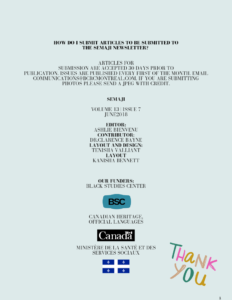We are seeking your participation in a video project to acknowledge and honor individuals from Black communities across Canada who have been lost to the Covid 19 pandemic.
The COVID-19 pandemic laid bare long-standing inequities in access to healthcare in Black and racialized communities. Black communities in Canada were disproportionately negatively impacted by the virus, in terms of infection and mortality rate. Black communities also bore a disproportionate economic burden with significant job loss and a higher number of business foreclosures during the pandemic than any other community.
Recognizing the specific need for positive intervention for Black Francophone and Anglophone communities in the greater Montreal region, an initiative to promote COVID-19 awareness and vaccine confidence among Black communities in the Montreal and Laval region was launched in May 2021. This initiative was done in collaboration with the Direction régionale de santé publique (DRSP) of Montreal and Laval, the Centres intégrés universitaires de santé et de services sociaux (CIUSSS) and several individuals, community organizations, and health professionals from Black communities who are mobilized around addressing the systemic issues and obstacles to vaccination. The collaborative developed several tools to promote information, awareness and access, including information townhalls, pop-up vaccine clinics and a powerful 6-part Public Awareness Video campaign which you can view here: http://qbma.ca/vaccination-covid-19/
As we are approaching the second anniversary of the start of the pandemic, the collaborative wishes to use the final video in the series for an In Memoriam Project. The three objectives are to call attention to the disproportionate impact that the COVID-19 had on Black communities across Canada; to honor those we lost during the last two years and put a face to the pandemic and to remind us that these are not statistics or data points on graphs – they are people, whose loss has left a significant impact on the loved ones left behind
We are collecting the names and pictures of the people from Black communities across Canada who passed away as a result of COVID-19. The images and names of the deceased individuals shared with us by their loved ones, will be assembled in a video produced by acclaimed director Jorge Camarotti.
In order to collect this information and amplify this important initiative, we are asking you to please share images and names of loved ones you’ve personally lost to the pandemic, and to also share the following form with individuals within your communities.
• Form:
https://docs.google.com/forms/d/1Cb6w80rJxuYKXv-Qkxy1IJs0LFNSBW5ujYWckdqsW80/prefill
Please note that the images and information shared through the form will only be used as part of the In Memoriam Project and will not be communicated to another party or for any other purpose.
Starting April 8, DESTA will be offering literacy and communication classes in mother tongue English and basic French, provided by the Galileo Adult Education Centre of the English Montreal School Board.
These classes will offer students an individualized learning experience, providing them with the language skills necessary to become work-ready or return to school.
English classes will be offered from 9 AM to 12 PM, and French classes from 1 PM to 4 PM, Monday through Thursday, until June 21, 2019.
Cost: $80 per course (includes books)
Registration begins March 19, 2019
We are booking registration appointments, call 514-664-5042 for more information or to book an appointment.
*Reduced rates and stipends are available to qualifying DESTA participants.
Please note that the English class is not an English Second Language (ESL) course, but is for speakers with first language proficiency.
[gview file=”https://bcrcmontreal.com/wp-content/uploads/2019/02/SEMAJI-13-8-August.pdf”]
[gview file=”https://bcrcmontreal.com/wp-content/uploads/2019/01/SEMAJI-14-6-MAY-1-1.pdf”]
Over the past year, the Standing on Their Shoulders project has attempted to encourage young griots in our communities.
Deriving from West African traditions, the griot, or “jeli” profession involves several responsibilities. Griots serve the role of public historians and storytellers, yet there is no word in a Western vocabulary that could properly speak to their realm of tasks:
“A traditional griot could do everything from recounting history to composing music, to teaching students, to acting as diplomats. They are genealogists, historians, spokespeople, ambassadors, musicians, teachers, warriors, interpreters, praise-singers, masters of ceremonies, advisors, and more. Not every griot does all of these things, but these are all examples of functions the griot profession embodies.”[i]
Though the traditional role of the griot in some uses of the word may be strictly defined, and unique to certain regions, part of the approach of Standing on Their Shoulders is recognizing that certain principles which undergird griot-ship, such as orality, storytelling, community empowerment through self-knowledge, are rather widespread, and have evolved in the diaspora in particular ways. It is these underlying connections that we attempted to draw on for Standing on Their Shoulders.
A classic example of a story that has been passed down through griot traditions (often through song), is Sundiata, an epic of 14th century Mali.[ii] The basic structure of the story is quite similar to Shakespeare’s Hamlet, although Shakespeare’s play was conceived nearly three centuries after Sundiata. Interestingly, Hamlet is often identified as the basis for Disney’s Lion King, while “Sundiata” literally translates to “the lion king”.[iii]
Our effort to engage our communities’ griots is also inspired by the principle of “Sankofa”: the shortened version of an Akan principle symbolized by the goose reaching backwards.[iv] The rough translation of the proverb is “it is not taboo to go back and fetch that which you have left behind”. More simply: “go back and fetch it!”. This is the methodological principle used in the archival work of Dr. Dorothy Williams (see her thesis on black periodicals).[v] Though the Sankofa principle is mostly associated with back to Africa movements, the “Standing on their Shoulders” project applies the Sankofa principle to our work in a localized sense.
Article by Kai Thomas
Image by Kathleen Atkins Wilson
[i] https://www.bucknell.edu/Documents/GriotInstitute/What%20is%20a%20Griot.pdf
[ii] https://www.youtube.com/watch?v=AM8hx0ooQMY
[iii] http://eric.ed.gov/?id=ED386732
[iv] http://www.adinkra.org/htmls/adinkra/sank.htm
[v] http://www.collectionscanada.gc.ca/obj/thesescanada/vol2/002/NR25286.PDF
Standing on Their Shoulders animators Pharaoh and Jennifer sat down with performer Skipper Dean in his home to talk about music, performing, and growing up in Little Burgundy.
Seated in front of his immense record collection, he spoke to us with a soft and collected voice that could only belong to a soul-singer.Yet before he was a dynamite rhinestone-clad performer, touring the world and singing with other legends, he was a boy from Little Burgundy.
“It was a village” he says, recalling how everyone knew each other. “If I did something wrong down on Mountain Street, by the time I got down to Canning Street”, he recalls, “People poked their heads out saying ‘Just wait till you get home!’”.
From encountering famous musicians looking for directions to local clubs, to sneaking backstage to meet The Vibrations and Patti Labelle, his stories of Little Burgundy are full of fond memories, getting into trouble, and most importantly, full of music.
On March 20th, 2015, the Standing on Their Shoulders animators joined the enthusiastic youth from James Lyng High School’s 10th grade history and French classes on their walking tour of Little Burgundy. The walking tour was a conclusion of a week-long series on the History of Little Burgundy where the students were taught about the historic landmarks, and watched the “Burgundy Jazz” web documentary, written and directed by David Eng. A particular element of this project was that the youth were given images of old pictures and asked to reproduce them (the images) as they stand today.
All the sites were amazing and very educational, but the piece-de-resistance was when the youth stopped at Tyndale St-Georges Community center for lunch. After an amazing lunch provided by Boom J’s, Dr. Dorothy Williams, Ethel Bruneau, & Skipper Dean were invited to answer questions the youth had prepared for them. The students were excited at the chance to meet celebrities who appeared in the documentary series and the opportunity to interact with them would surely be treasured memories for years to com



